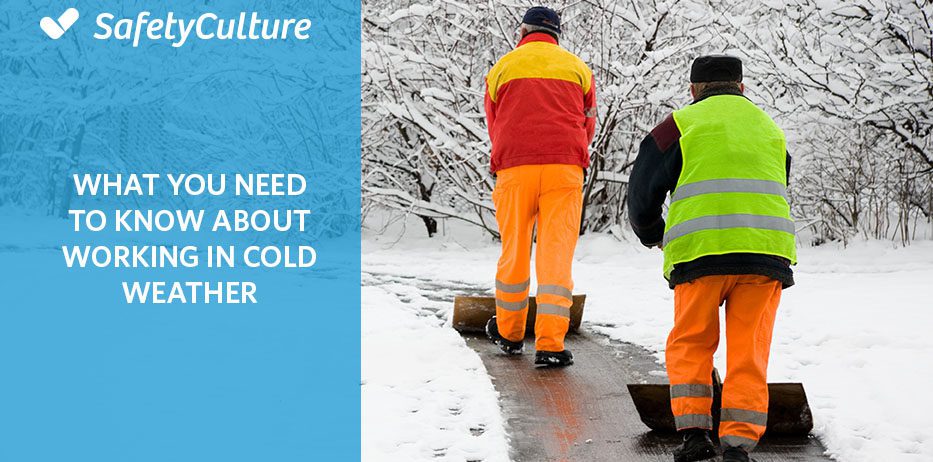Cold Working Conditions: What You Need To Know
Industry Trends | By | 4 Jan 2016 | 3 minute read

Cold stress is a real danger to outdoor workers at this time of the year. But it’s not always possible to plan work according to the weather. If emergency tasks have to be tackled, workers have to venture outdoors, and could suffer prolonged exposure to cold.
When the weather is very cold, the body has to work much harder to maintain its core temperature, and if there’s a wind blowing, or the weather is wet, the problem is compounded. The skin temperature drops first, and then the body’s core temperature begins to fall. This can lead to various health problems, and in worst case scenarios hypothermia and even death.
Risk factors
The risks of exposure to cold are increased when:
- Workers are not dressed warmly
- Fatigue and exhaustion set in
- Wet or damp conditions prevail
- Employees suffer from certain health problems. For example, hypertension, diabetes and thyroid problems increase the risk of cold stress injuries
The consequences of cold stress
Hypothermia, frostbite and trench foot are common injuries that can occur when workers are exposed to cold stress. And although being exposed to cold can’t actually make you ill, your immune system doesn’t work as it should when your body is chilled.
However, hypothermia is the greatest danger. At first, the worker may shiver, but as the body’s temperature drops, shivering stops. Coordination becomes poor, and confusion and disorientation set in. Hypothermia is an emergency medical condition, and if it is suspected, it’s important to take action immediately. Keep the patient warm and dry and get medical attention as soon as possible.
Frostbite and trench foot are both forms of tissue damage caused by extreme cold, and once again, medical assistance should be sought as soon as either condition is suspected. At worst, frostbite can lead to amputations, so it should not be taken lightly.
What can be done to prevent cold stress injuries?
Prevention is always better than a cure. These tips will help you to protect workers from injury:
- Employees must be trained to protect themselves and to recognise symptoms of cold stress. They also need to know what to do in a cold stress emergency.
- Engineering controls such as radiant heaters and wind protection should be used when possible.
- Provide hot drinks and try to schedule work for the warmest possible times of day.
- Workers should work in pairs or teams so that they can monitor each other for symptoms of cold stress. Allow frequent breaks in a warmer, drier area.
What workers should wear
Three layers of loose fitting and insulating clothing should be worn. Two of these should consist of wool or a synthetic fabric that keeps the skin from getting moist. The outer layer should protect the worker from wind and rain. Hats help to keep the body from losing as much heat, and wool face masks can also be used. Insulated gloves and waterproof boots help to protect against frostbite.
The benefits of providing good cold exposure management
Following OSHA tips and regulations to manage cold stress prevents unnecessary workplace injuries. Apart from reducing downtime from direct cold injuries, you’ll also reduce injuries that indirectly result from cold exposure. When workers experience cold stress, they’re more prone to errors, and there is temptation to take dangerous ‘shortcuts’ that could cause accidents.
Training is of particular importance, and foremen should be alert to the dangers of cold stress, ensure that workers are properly dressed and perform safety inspections regularly. Although OSHA does not require employers to provide specific forms of PPE against cold as part of their standards, it could be a worthwhile investment! Keep it in mind during your next safety audit!
Download the Cold Weather Safety Checklist
Tip: The above checklist is best downloaded when you’re on your device. It opens up into iAuditor.
Important Notice
The information contained in this article is general in nature and you should consider whether the information is appropriate to your specific needs. Legal and other matters referred to in this article are based on our interpretation of laws existing at the time and should not be relied on in place of professional advice. We are not responsible for the content of any site owned by a third party that may be linked to this article. SafetyCulture disclaims all liability (except for any liability which by law cannot be excluded) for any error, inaccuracy, or omission from the information contained in this article, any site linked to this article, and any loss or damage suffered by any person directly or indirectly through relying on this information.






